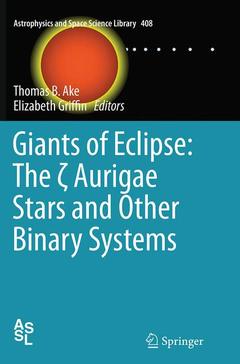Description
Giants of Eclipse: The ζ Aurigae Stars and Other Binary Systems, Softcover reprint of the original 1st ed. 2015
Astrophysics and Space Science Library Series, Vol. 408
Coordinators: Ake Thomas B., Griffin Elizabeth
Language: English
Subject for Giants of Eclipse: The ζ Aurigae Stars and Other Binary...:
Publication date: 09-2016
Support: Print on demand
Publication date: 01-2015
202 p. · 15.5x23.5 cm · Hardback
Description
/li>Contents
/li>Biography
/li>Comment
/li>
The zeta Aurigae stars are the rare but illustrious sub-group of binary stars that undergo the dramatic phenomenon of "chromospheric eclipse". This book provides detailed descriptions of the ten known systems, illustrates them richly with examples of new spectra, and places them in the context of stellar structure and evolution.
Comprised of a large cool giant plus a small hot dwarf, these key eclipsing binaries reveal fascinating changes in their spectra very close to total eclipse, when the hot star shines through differing heights of the "chromosphere", or outer atmosphere, of the giant star. The phenomenon provides astrophysics with the means of analyzing the outer atmosphere of a giant star and how that material is shed into space. The physics of these critical events can be explained qualitatively, but it is more challenging to extract hard facts from the observations, and tough to model the chromosphere in any detail.
The book offers current thinking on mechanismsfor heating a star's chromosphere and on how a star loses mass, and relates this science synergistically to studies of other stars and binaries, and to the increasing relevance of contributions from new techniques in interferometry and asteroseismology. It also includes a detailed discussion of the enigmatic star epsilon Aurigae, which had recently undergone one of its very infrequent and very baffling eclipses. Though not a zeta Aurigae system, epsilon Aurigae is a true "Giant" among eclipsing stars.
The 7 chapters of this book, written by a group of experts, have been carefully edited to form a coherent volume that offers a thorough overview of the subject to both professional and student.
The zeta Aurigae Binaries.- Observing and Analyzing the zeta Aurigae Systems.- The Special Case of VV Cephei.- zeta Aurigae – a Two Century Long Dilemma Persists.- Atmospheric Heating and Wind Acceleration in Cool Evolved Stars.- Optical Interferometry of Giants and Supergiants.- Asteroseismology of Eclipsing Binary Stars.- Index of Keywords.
For many years Dr Griffin pursued research into stellar spectra, principally of composite-spectrum binaries, at Cambridge (UK), supporting it with observations acquired at major telescopes overseas. She now continues those interests in Canada, at the Dominion Astrophysical Observatory near Victoria, and makes her observations there. The prime research objectives are to determine the masses and other fundamental parameters of both component stars, and to examine their evolutionary status. She also champions initiatives to recover the information in pre-digital (photographic) observations through programmes of appropriate digitization.
Dr. Ake is a Program Director at Computer Sciences Corporation supporting the Hubble Space Telescope, the James Webb Space Telescope, the Milkulski Archive for Space Telescopes, and the Kepler Data Management Center projects at Space Telescope Science Institute. His research interests center on evolved stars and binary systems, particularly UV andFUV spectroscopic investigations from space of red giants and supergiants with hot secondary companions. He is currently studying the evolutionary status of cool stars with main sequence B- and A-type secondaries to refine the fundamental stellar parameters of the evolved components.
These books may interest you

Planets in Binary Star Systems 158.24 €



